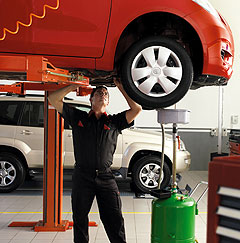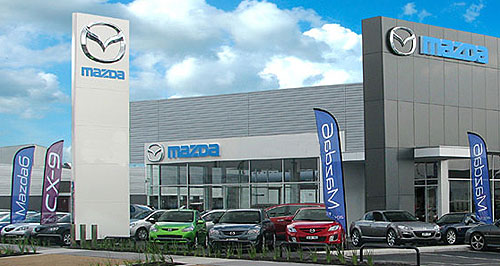News - General NewsMazda first for serviceTrue blue: Mazda dealers roll out the red carpet for service customers. Japanese brands top JD Power’s first vehicle service survey in Australia26 Oct 2010 MAZDA has emerged as the standout performer in the first survey of aftersales customer service satisfaction done in Australia by respected global marketing information company JD Power. The booming Japanese brand was the only vehicle brand to score more than 800 out of a maximum 1000 points in JD Power’s inaugural Australian vehicle service satisfaction survey. Mazda (806 points), Toyota (800), Honda (798) and Subaru (790) were the only brands to place above the industry average of 786 points. The results are based on responses from more than 4550 owners of 25 different makes who had their vehicles serviced at authorised service centres between July 2009 and August 2010. JD Power Asia Pacific’s 2010 Australia Customer Service Index (CSI) Study measures new-vehicle owner satisfaction with the aftersales service process by examining authorised dealership performance in five factors. In order of weighting, they are: service quality (25 per cent), vehicle pick-up (20 per cent), service advisor (20 per cent), service initiation (18 per cent) and service facility (17 per cent).  While some volume-selling Japanese brands starred, the study also found that nearly one in 10 new-vehicle owners in Australia said repair and maintenance service was not completed correctly the first time. Overall, nine per cent of respondents said their dealer failed to service their car properly the first time. While some volume-selling Japanese brands starred, the study also found that nearly one in 10 new-vehicle owners in Australia said repair and maintenance service was not completed correctly the first time. Overall, nine per cent of respondents said their dealer failed to service their car properly the first time.When it came to repair work, a surprising 19 per cent said their vehicle was not fixed correctly. JD Power Asia Pacific’s Singapore-based executive director Mohit Arora said that having repair or maintenance work done correctly the first time had a significant impact on a customer’s satisfaction with dealer services. Satisfaction among customers whose service work was not done correctly the first time was 186 points lower, on average, than that of customers whose service was done right the first time, said JD Power. “New-vehicle owners in Australia hold dealerships to high standards for service quality,” said Mr Arora. “Service quality is a key component of the overall service satisfaction, and providing high-quality service may help dealerships strengthen perceptions of the value they provide. “Customers in Australia are particularly sensitive to problems experienced at vehicle delivery. The initial quality of a vehicle has significant influence on customer perceptions of the brand and dealership throughout the ownership period.” Mazda, which was also named by JD Power as the most satisfying brand among Australian new-vehicle owners for the second consecutive year in 2009, was rated the highest of 12 brands ranked in the aftersales study after performing particularly well in the service initiation and service advisor factors. Mazda Australia has focused on customer (and dealer) satisfaction since the days of previous managing director Malcolm Gough, when the brand had a dearth of exciting new models. The market share of the Australian subsidiary, which Mazda Motor Corporation says conducts “industry-best practice”, is the second-largest in the Mazda world behind Israel. “Mazda demonstrates strong performance in each of the factors that drive satisfaction, as well as in several key activities that have a positive effect on satisfaction,” said Mr Arora. “These activities include providing post-service communications such as explanations of work and charges, and having vehicles ready when promised.” In contrast, brands deemed to have delivered below-average aftersales service included Ford (785 points), Nissan and Volkswagen (780), Mitsubishi (777), Hyundai (774), Holden (768), Kia (747) and Suzuki (743). A number of other brands were included in the study but not ranked due to their small sample size, including Audi, BMW, Citroen, Chrysler, Jaguar, Jeep, Land Rover, Lexus, Mercedes-Benz, Peugeot, Renault, Saab and Volvo. According to JD Power, service satisfaction levels have a strong impact on customer advocacy and loyalty rates, with about 87 per cent of highly satisfied customers (those with service satisfaction scores averaging above 899) saying they “definitely would” revisit their dealership for paid service work. Conversely, only 10 per cent of dissatisfied customers (those with satisfaction scores averaging 700 and lower) said the same. Similarly, while 60 per cent of highly satisfied customers said they “definitely would” repurchase their vehicle brand, only 21 per cent of highly dissatisfied customers said the same. The JD Power study found that one in 10 service customers in Australia reported having experienced at least one problem with their new vehicle at delivery. Among those customers, satisfaction with dealer service averages 56 points below the industry average, while 47 per cent of those customers said they were “disappointed” with the operating costs of their vehicle. Some 60 per cent of those surveyed said the convenience of its location was the main reason for choosing an authorised dealer for their most recent service visit. Other popular reasons were because they bought their vehicle there (49 per cent), reliability of service (46 per cent), qualified mechanics (42 per cent), warranty (39 per cent), authorised parts (39 per cent), speedy service (33 per cent), past experience (32 per cent), open on convenient days/hours (25 per cent), competitive/good price (19 per cent), free service (nine per cent), recommendations from family/friends (seven per cent) and that they knew someone at the dealership (four per cent). In terms of vehicle problems at delivery, Ford topped the JD Power survey with 18 per cent of respondents claiming they had an issue, followed by Kia (15 per cent), Holden (14 per cent), Volkswagen (12 per cent), Mitsubishi (10 per cent), Hyundai, Nissan and Subaru (nine per cent), Honda, Suzuki and Toyota (seven per cent) and Mazda (six per cent). Ninety-five per cent of Honda and Toyota owners surveyed said work on their vehicle was completed correctly the first time, followed by Mazda and Hyundai (93 per cent), Nissan, Subaru and Suzuki (92 per cent), Kia and Mitsubishi (90 per cent), Ford (89 per cent), Holden and Volkswagen (88 per cent).  Read more |
Click to shareGeneral News articlesResearch General News Motor industry news |















Facebook Twitter Instagram